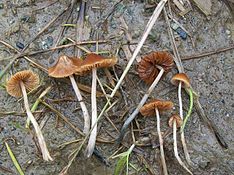- Conocybe cyanopus
-
Conocybe cyanopus 
Conocybe cyanopus Scientific classification Kingdom: Fungi Division: Basidiomycota Class: Agaricomycetes Order: Agaricales Family: Bolbitiaceae Genus: Conocybe Species: C. cyanopus Binomial name Conocybe cyanopus
(Atkins) Kuhner
Approximate range of Conocybe cyanopus Synonyms Pholiotina cyanopoda
Conocybe cyanopoda
Galerula cyanopusConocybe cyanopus Mycological characteristics 
gills on hymenium 

cap is conical
or convex
hymenium is adnate 
stipe is bare 
spore print is brown 
ecology is saprotrophic 
edibility: psychoactive Conocybe cyanopus is a member of the genus Conocybe which contains the medicinal compound psilocybin.[1] It is formerly known as Pholiotina cyanopoda, Conocybe cyanopoda, and Galerula cyanopus.
Contents
Description
Conocybe cyanopus is a small saprotrophic mushroom with a conic to broadly convex cap which is smooth and colored ocher to cinnamon brown. It is usually less than 25 mm across and the margin is striate, often with fibrous remnants of the partial veil. The gills are adnate and close, colored cinnamon brown with whitish edges near the margin, darkening in age. The spores are cinnamon brown, smooth and ellipsoid with a germ pore, measuring 8 x 5 micrometers. The stem is smooth and fragile, whitish at the bottom and brownish at the top, 2-4 cm long, 1 to 1.5 mm thick, and is equal width for most of the length, often swelling at the base. The stem lacks an annulus (ring) and the base usually stains blue.
The cap color lightens when it dries, turning a tan color.
Like some other grassland species such as Psilocybe semilanceata, Psilocybe mexicana and Psilocybe tampanensis, and Conocybe cyanopus, may form sclerotia, a dormant form of the organism, which affords it some protection from wildfires and other natural disasters.[2]
Distribution and habitat
Conocybe cyanopus grows in lawns, fields, grassy areas, but is rare.
It is known to occur in cool climates of North America and Europe, but is probably more widely distributed. It can be found in British Columbia,[3] Colorado, New York, Oregon, Washington),[3] Finland, Germany and Norway.[3]
Edibility
Hallucinogenic, containing psilocin, psilocybin, and baeocystin. This mushroom contains between 0.5 to 1.0 percent psilocybin. Most mycologists recommend against eating this mushroom because it is easy to mistake for poisonous species.
Potency
Fruit bodies have been found to contain anywhere from 0.33–1.01% psilocybin, 0–0.007% psilocin, and 0.12–0.20% baeocystin.[4]
See also
References
- ^ Ammirati, Joseph (1986), "Poisonous mushrooms of the northern United States and Canada", books.google.co.uk, ISBN 978-0816614073, http://books.google.co.uk/books?id=nhWbsGB7z4cC&pg=PA187, retrieved 1 September 2011
- ^ Psilocybin Mushrooms of the World -- An Identification Guide, Paul Stamets, 1996. ISBN 0-89815-839-7 p.24
- ^ a b c Guzmán G, Allen JW, Gartz J. (1998). "A Worldwide geographical Distribution of the neurotropic fungi, an analysis and discussion". Ann. Mus. civ. Rovereto Sez. 14: 189–280. http://www.museocivico.rovereto.tn.it/UploadDocs/104_art09-Guzman%20&%20C.pdf Referred to in the paper as Gymnopilus spectabilis]
- ^ Stamets (1996), p. 177.
- Stamets, Paul. (1996). Psilocybin Mushrooms of the World. Berkeley, CA: Ten Speed Press. ISBN 0898158397
External links
Categories:- Bolbitiaceae
- Psychoactive fungi
- Psychedelic tryptamine carriers
Wikimedia Foundation. 2010.
